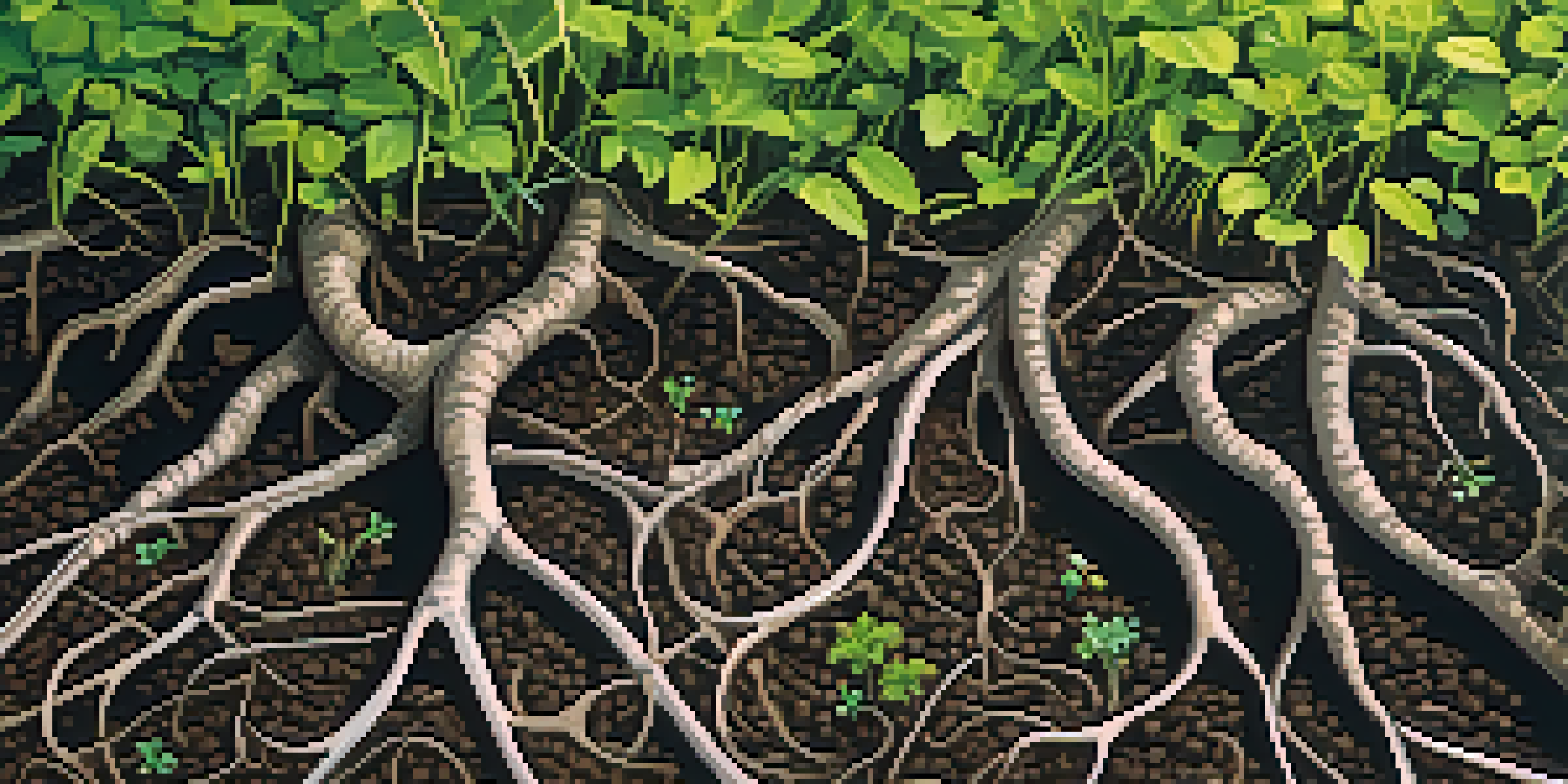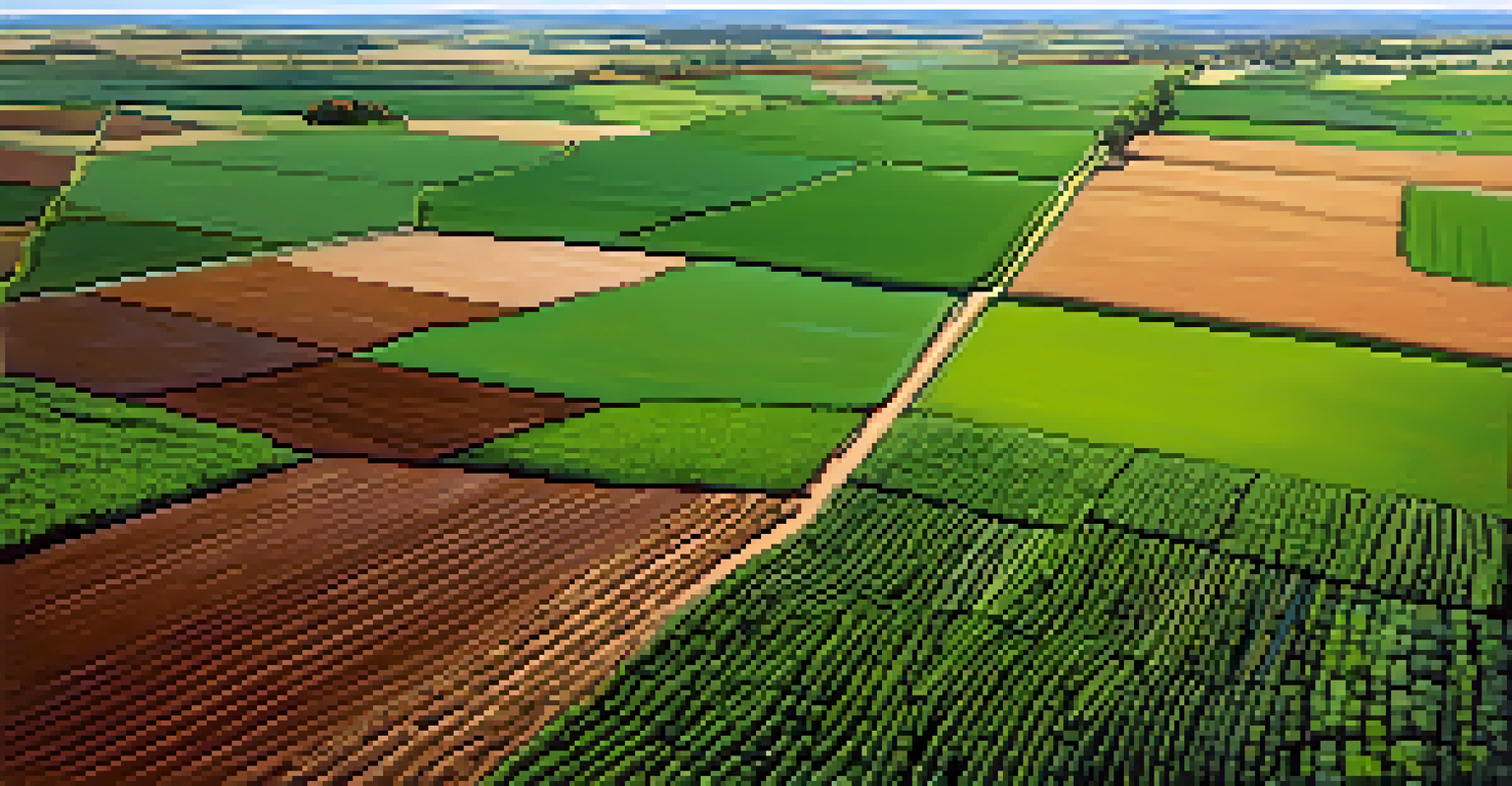The Crucial Role of Plants in Soil Erosion Prevention

Understanding Soil Erosion and Its Impact
Soil erosion is the process where the top layer of soil is worn away, often due to wind or water. This can lead to decreased soil fertility, making it difficult for plants to grow, which in turn affects food production. When soil erodes, it can also result in sedimentation in waterways, harming aquatic ecosystems and water quality.
The soil is the great connector of our lives, the source and destination of all. Food, fiber, shelter - it is the basis of our economy, and the health of our ecosystems.
The consequences of soil erosion extend beyond the immediate area; it can lead to landslides, loss of arable land, and even contribute to climate change by releasing stored carbon. The impact on agricultural productivity can be devastating, leading to food shortages and economic challenges for communities. Thus, preventing soil erosion is vital for maintaining a healthy environment and economy.
To effectively combat soil erosion, it's essential to understand the natural processes at play. This is where plants come into the picture, acting as a natural barrier and a stabilizing force for the soil. Their roots intertwine with the soil, creating a network that keeps it in place, while their foliage helps reduce the velocity of wind and rainfall.
How Plants Stabilize Soil with Roots
Plants play a crucial role in soil stabilization, primarily through their root systems. The roots of plants extend deep into the ground, anchoring the soil and preventing it from being washed or blown away. This anchoring effect is especially important on slopes and in areas prone to heavy rainfall.

Beyond just anchoring, different plants have varying root structures that can enhance soil stability. For instance, deep-rooted plants like trees not only stabilize the surface but also help break up compacted soil layers, improving drainage and aeration. This promotes a healthier ecosystem for other plants and organisms.
Soil Erosion Affects Food Production
Soil erosion reduces fertility, impacting plant growth and leading to potential food shortages.
Moreover, the presence of vegetation can also encourage soil microbial activity. Healthy root systems contribute to organic matter in the soil, which increases its structure and nutrient-holding capacity. This holistic approach to soil health not only prevents erosion but also fosters a vibrant ecosystem.
The Role of Vegetation in Water Absorption
Vegetation plays a significant role in water absorption, which is crucial in preventing soil erosion. When it rains, plants intercept rainfall, allowing water to soak into the ground rather than running off the surface. This reduces the likelihood of surface erosion caused by fast-moving water.
The best time to plant a tree was twenty years ago. The second best time is now.
Additionally, plants help to create a sponge-like effect in the soil, holding moisture and gradually releasing it into the environment. This is especially beneficial in dry regions, where maintaining soil moisture is vital for agricultural productivity. Improved water retention means that the soil is less likely to dry out and become susceptible to erosion.
Furthermore, the roots of plants enhance soil structure, promoting better infiltration rates. When soil is well-structured, water can percolate gradually, reducing runoff and erosion. This relationship between vegetation and water absorption is critical for sustainable land management.
Native Plants: A Natural Solution for Erosion Control
Native plants are particularly effective in preventing soil erosion, as they are adapted to the local environment. They typically require less water and maintenance, making them a sustainable choice for landscaping and erosion control. Their deep-root systems help stabilize the soil while providing habitat for local wildlife.
By incorporating native plants into erosion-prone areas, we can enhance biodiversity and create a more resilient ecosystem. These plants are often better suited to withstand local climatic conditions, which means they are less likely to fail during periods of drought or heavy rainfall. This resilience is key to maintaining soil integrity.
Plants Stabilize Soil Effectively
The root systems of plants anchor the soil, preventing erosion and promoting a healthier ecosystem.
Moreover, planting native vegetation can reduce the need for chemical fertilizers and pesticides, promoting a healthier environment. This natural approach not only prevents erosion but also supports overall ecosystem health, making it a win-win for both nature and communities.
Cover Crops: Protecting Soil Between Growing Seasons
Cover crops are an excellent tool for preventing soil erosion during the offseason when main crops are not growing. These crops, such as clover or rye, are planted specifically to cover the soil and protect it from erosion. Their roots help hold the soil in place, while their foliage shields the soil from wind and rain.
In addition to erosion control, cover crops also improve soil health by adding organic matter when they decompose. This increases soil fertility and enhances its structure, making it more resilient to erosion in the long run. Cover crops can also suppress weeds, reducing competition for nutrients.
Farmers who utilize cover crops often see improved yields in subsequent planting seasons. This practice not only contributes to sustainable agriculture but also helps maintain the integrity of the soil, ensuring it remains productive for future generations.
The Importance of Mulching for Soil Protection
Mulching is another effective strategy for preventing soil erosion, and it involves covering the soil with materials like straw, wood chips, or even leaves. This layer acts as a protective barrier, reducing the impact of raindrops on the soil surface and preventing soil compaction. By minimizing direct contact with rainfall, mulch can significantly reduce erosion.
In addition to protecting the soil from erosion, mulch also helps retain moisture and regulate soil temperature. This creates a more favorable environment for plant growth, which in turn contributes to soil stability. When plants thrive, their roots further anchor the soil, creating a cycle of protection.
Community Actions Combat Erosion
Local initiatives like tree planting and educational workshops can significantly enhance soil erosion prevention efforts.
Moreover, organic mulch breaks down over time, enriching the soil with nutrients. This not only improves soil health but also promotes a diverse ecosystem of organisms that contribute to soil stability. Thus, mulching is a simple yet effective practice for anyone looking to protect their soil.
Community Efforts in Soil Erosion Prevention
Community involvement is essential in the fight against soil erosion, as collective action can lead to significant change. Local initiatives can include tree planting drives, educational workshops on sustainable practices, and the implementation of community gardens. These efforts not only help combat erosion but also foster a sense of community and environmental stewardship.
Engaging local stakeholders, such as farmers, schools, and environmental groups, can amplify the impact of erosion prevention strategies. By sharing knowledge and resources, communities can support one another in adopting practices that protect their land. This collaborative spirit can lead to innovative solutions tailored to local needs.

Additionally, government policies and programs that support soil conservation can reinforce community efforts. Providing financial incentives for sustainable practices or funding for restoration projects can empower communities to take action. Together, these initiatives create a powerful movement toward sustainable land management and soil erosion prevention.